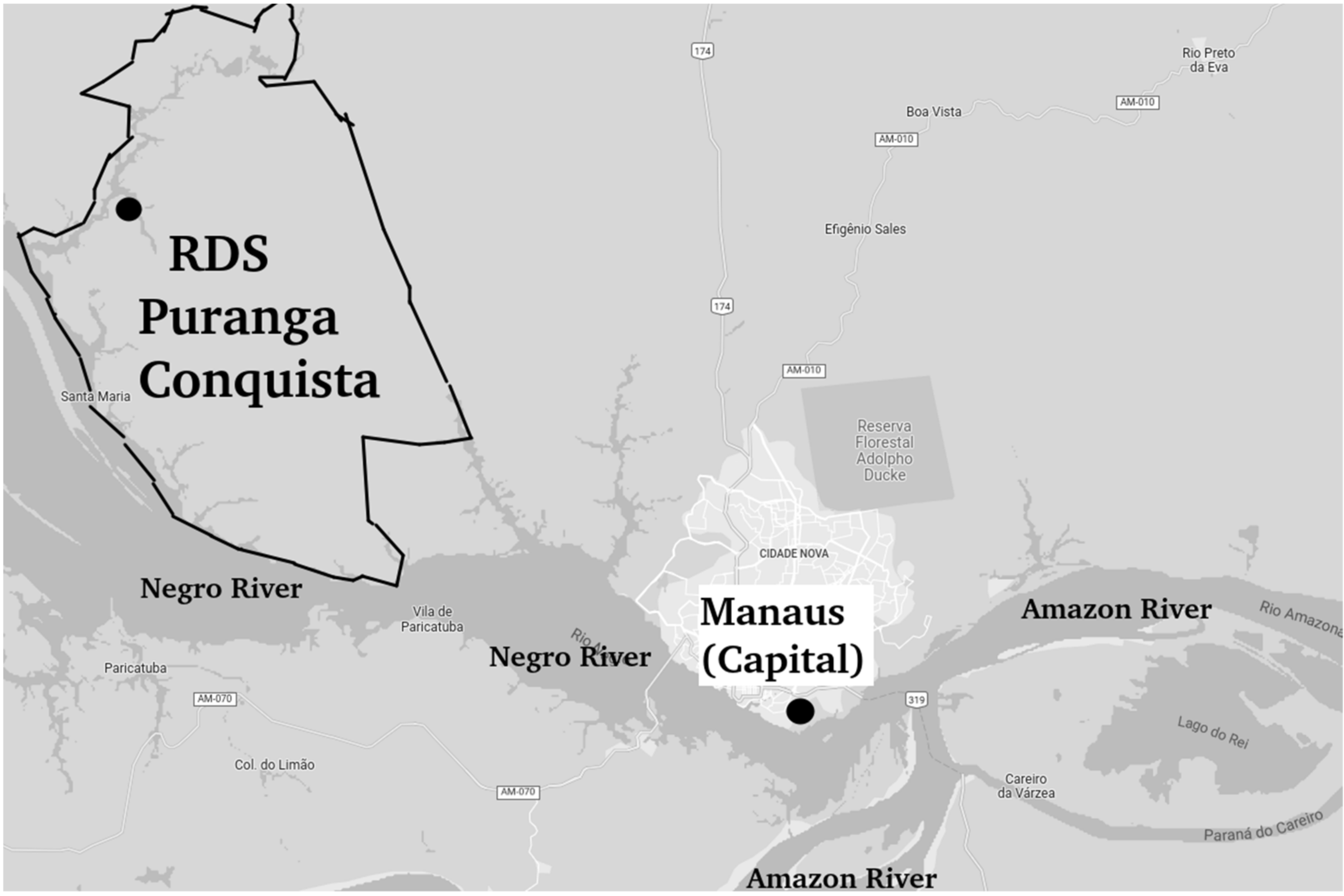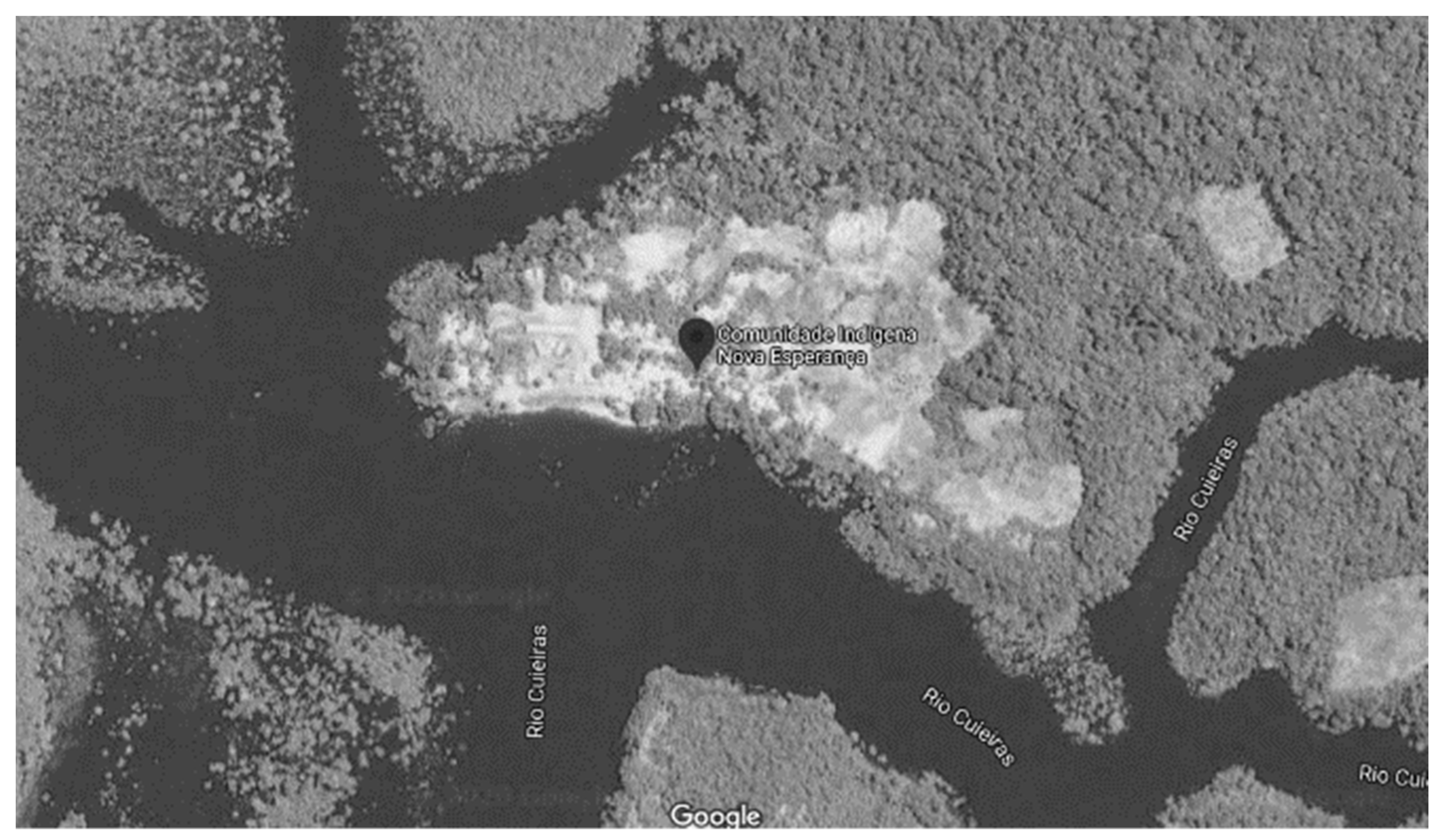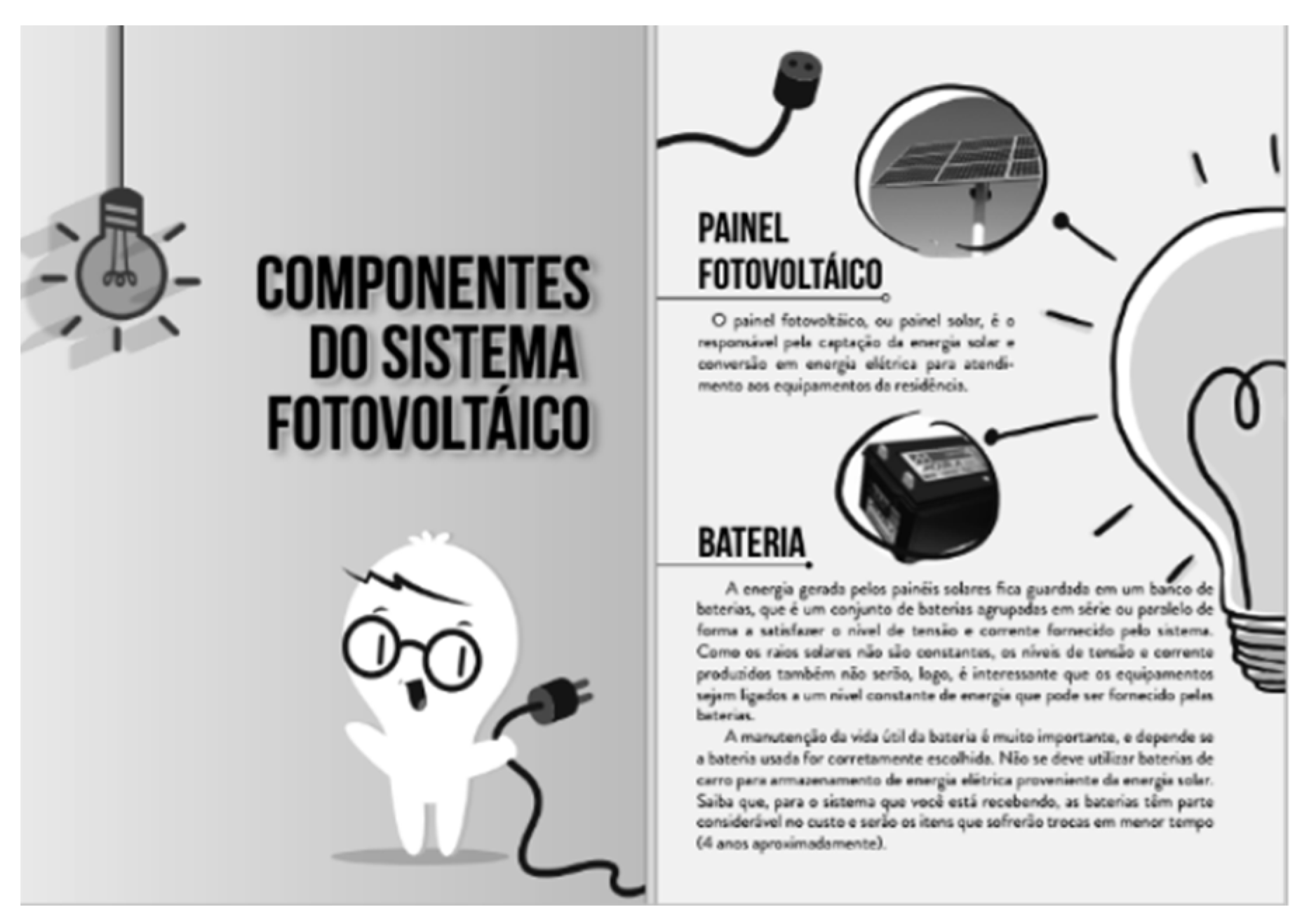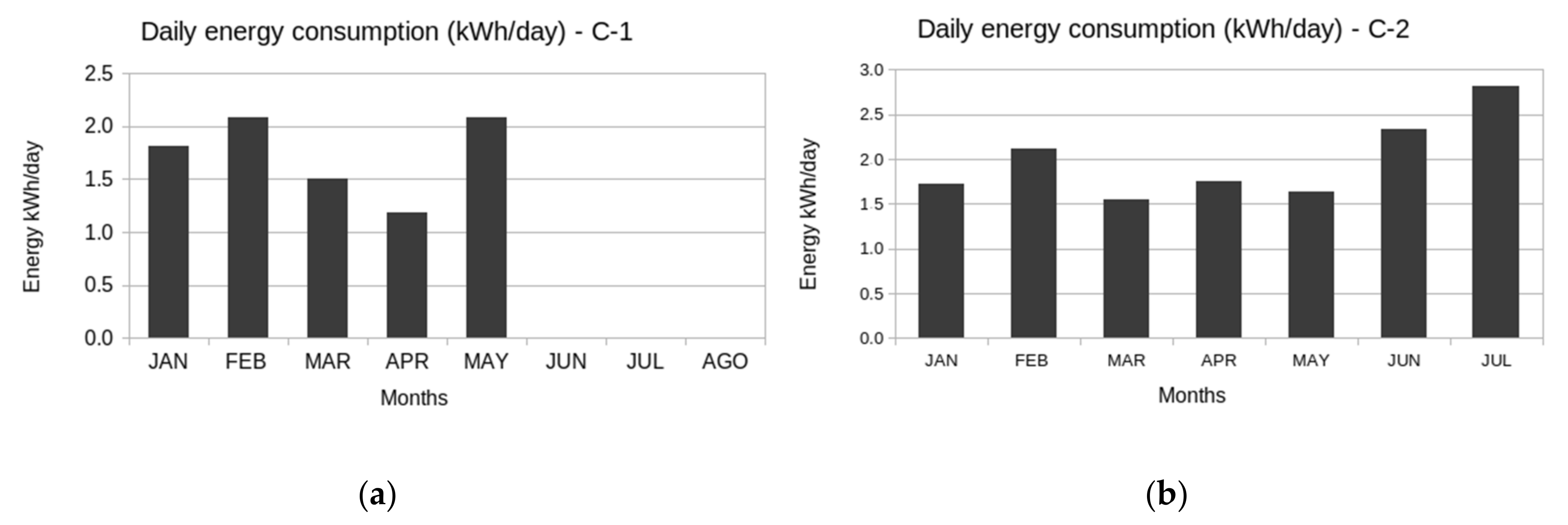1. Introduction
The lack of access to clean and accessible energy is considered a central dimension of poverty [
1]. Progress has been made, but 10% of the world population had no access to electricity in 2020 [
2]. In relation to Brazil, the country faces chronic energy shortages, especially in remote riverside communities in the Amazon basin region, where logistical issues, high demand for investment, low income for the riverine dwellers, and environmental impact are challenging issues.
Besides the efforts to promote universal access to electrification, the Brazilian Amazon basin has yet 82,000 families (350,000 people) without electricity, according to the Brazil Federal Government [
3]. However, some sources [
4] indicate that this number could reach 3.5% of Brazil’s total population, or 990,000 ‘electrical excluded’ people, mainly indigenous people and residents of environmental conservation units. This is a relatively small number, considering Brazil’s population, but difficult to reduce, considering the challenges of the region. Note that Amazon state has only five federal highways and five state highways, the highway BR-174 being the only one that connects the capital, Manaus, to another state, and is passable throughout the year. There are few airports, with only two being enabled for landing and takeoff of large aircraft. In this scenario, it is the rivers and the Amazon waterway network, considered the largest in the world, that constitutes the main means of transport (of people and goods) for residents of the municipalities of the interior and riverside communities.
On one hand, two federal government programs aim to provide access to energy to all through micro-grids and stand-alone systems, through renewable energy sources, or diesel and/or hybrid systems for remote communities in which network connection is not a viable option [
5]: the ‘Luz para Todos’ (“Light for All”) federal program since 2003, and the yet unregulated program ‘Mais Luz para a Amazônia’ (“More Light to the Amazon”) since 2020, the goals related to the Amazon basin were underrated and far to be reached. On the other hand, the state program created in 2007, ‘Bolsa Floresta’ (PBF), aims to encourage the conservation of forests through sustainable use.
The ‘Luz para Todos’ program was fruitful when the extension of the electric grid was feasible, managing to evolve quickly with the universalization of locations where this modality was possible. However, the difficulties of distance and housing isolation in Amazon basin communities brought a challenge (both logistical and cost-effective) that only the new ‘Mais Luz para a Amazônia’ program will be able to address. This new program prioritizes low-income families enrolled in Social Programs of the Federal Government, schools, health centers, community water wells, families living in conservation units, rural settlements, indigenous communities, and extractive reserves.
This paper presents a case study of the use of photovoltaic solar energy on an indigenous community of 36 houses in the RDS Puranga Conquista conservative area, distanced around two hours by fast boat from Manaus. The community is accessed only by the Cuieiras River, has a good community organization, and generates income with tourism and crafts. Due to having an elementary and high school, the community has a diesel generator that works 11-h a day, which is maintained by the Education Secretary.
The deployment started in 2018, using individual systems designed according to the electrical demand of the houses, which were previously visited and evaluated for electrical charges. The same 975 Wp solution and 48-h autonomy with lead-acid batteries were adopted in a total of six homes in the period from 2018 to 2019.
The study shows the method for choosing the community and houses to be electrified. The study shows the project with solar photovoltaic energy and contemplates a local monitoring system. The electrical charges are presented at the beginning of the project and after 13 months of electrification, as well as the actual consumption of electricity of each house. It is shown how the governance of the energy use of each house occurred, as well as the increase in income in half of the households and its electrical demand, which rose by 300%, and 50% improved their income after the electrification. We estimate the greenhouse gas emissions annually avoided after electrification, as the new source of generation, which is renewable, replaced one that consumed fossil fuel. The project also estimated the expenditure on energy sources that dwellers used due to the lack of electricity, which they stopped doing after electrification. The avoided expense was advised to be used as savings to cover maintenance costs over the years. In the end, it is explained which United Nations Sustainable Development Goals were achieved by the project and leaves clues for similar projects and actions to occur in the Amazon to remove communities from darkness and be able to bring sustainable development to the most remote places in Brazil. The innovativeness of this paper is related to the fact that there is no previous electrification research in this specific area of the Amazon basin, including the post-deployment follow-up and monitoring.
3. Methodology
Fifteen riverside communities in three conservation units around Manaus, Amazon State, Brazil were visited. Of these, a total of 14 non-electrified communities were the subject of a survey, conducted in each home, in order to collect data from the resident family, covering 56 questions divided into 9 sections, including data on the homeowner, information on the type of housing, family structure and education of all residents, productive activities, food, health, needs and aspirations, energy assessment (including use of batteries, candles, lamps, and diesel generators) and the electrical demand of the electronics found in an inspection of the house. The questionnaire followed the script of questionnaires prepared by the World Bank [
10]. The surveys occurred in June and August of 2017. Due to the budgetary limitations of the project, only one community was chosen (among the 14 where data was collected) and, in total, 6 houses were electrified between the years 2018 and 2019. However, only four of them received a monitoring system for data collection generation and energy consumption. The Nova Esperança community was chosen for presenting the best combination of community organization, the presence of income-generating activity, having a place for team accommodation during field activities (or being close to where there is accommodation), having a school in order to multiply knowledge transferred to residents, and distance to the capital Manaus (considering that several trips were necessary, every month, to enable monitoring of the functioning of the system and collection of data from the monitoring system). The post-monitoring phase includes data analysis and reports.
3.1. Electrification Project
With the chosen community, data from the applied survey in each family were taken and the load curve for each house in the community was estimated. This load curve considers all the equipment found in each place:
Estimated energy consumption from each one of the surveyed consumer units: 3.6 kWh/day, 9.4 kWh/day, 5.5 kWh/day, 5.9 kWh/day, 7.6 kWh/day, 3.9 kWh/day, 4.3 kWh/day, 2.5 kWh/day, 6.9 kWh/day, 13.7 kWh/day, 4.2 kWh/day, 11.6 kWh/day, 7.9 kWh/day, 0.8 kWh/day, 9.0 kWh/day, 6.6 kWh/day, 5.9 kWh/day, 8.4 kWh/day, 3.8 kWh/day, 1.9 kWh/day (church), 6.4 kWh/day (restaurant), 1.1 kWh/day (craft house), 1.0 kWh/day (hammock house), 1.4 kWh/day (community center), 24.5 kWh/day (school), 6.0 kWh/day (water pump);
For the closed houses, it was defined a standard load curve of 5.1 kW/day. Here, the dweller was not available to answer the surveys.
From now on, the targeted consumer units will be mentioned here as C-1, C-2, C-3, C-4, C-5, and C-6.
Figure 3 illustrates the estimated load curve for some houses that received electrification in Nova Esperança (C-1 and C-2), with a daily energy demand of 3.6 kWh, and 3.2 kWh, respectively. The methodology used for the estimation was to consider an average power consumption during the entire year, without impact from the seasons.
The type of electrification defined was with photovoltaic solar energy and a system of 975 Wp (3 solar panels of 325 W in series) and with an autonomy of 48 h [
11], implemented with four 220 Ah lead-acid batteries (2 in series and 2 in parallel) would meet the demand of each house (a single solution that would serve every chosen house).
Figure 4 illustrates the diagram of the adopted solution, already grown from the monitoring system developed by the Coventry University team. The choice of lead-acid batteries is based on the price, smaller than lithium batteries besides the lower lifetime.
The monitoring system adopted comprised the Raspberry Pi platform (model 3B), with software specially developed to collect data from the BMV700 battery monitor. In addition to plug-socket type devices for remote monitoring of energy consumption, model MIH005 collects data from consumer electronics connected to it (and the outlet) and transmits them wirelessly to the Raspberry Pi. Among the information collected, we can mention voltage, frequency, active power, reactive power. All data are collected every 10 s and stored on a USB memory locally. Due to the lack of community telecommunications infrastructure, local storage and periodic data collection were necessary.
The installations occurred in two stages: four houses in June 2018 on a 4-day journey and two more houses electrified in July 2019 on a 2-day journey. At the first installation, 3 technicians from the company that supplied the equipment were present, in addition to 3 undergraduate electrical engineering students from UFAM and a professor. In the second installation, only one professor and five students performed the activities.
3.2. Booklet and Dwellers Teaching
A booklet detailing the functioning of the solar system and energy efficiency measures was prepared. A detail of the booklet can be seen in
Figure 5. Several booklets were printed and distributed in the community. They served as a basis for the training given to residents. This training was essential because the dwellers could understand how solar photovoltaic systems work, why it is better to use more energy during daylight, and how to save energy using electrical items smartly.
4. Results
4.1. Related to the Project
We can list the following outcomes:
Three forms were created to collect data from the communities and the dwellers;
Three scholarships for undergraduate electrical engineering courses plus one Ph.D. scholarship;
Fourteen surveyed communities with GPS coordinates and photographs of each house;
Design of the solar photovoltaic system;
Design of the monitoring system;
Deployment of the systems;
Nine months of visiting;
Two agreements were signed among the partners;
Two datasets were built from data collected from the dwellers and the monitoring system.
4.2. Related to the Post Electrification and Monitoring
From July 2018 to March 2019, nine follow-up visits were carried out, with a collection of monitoring data and interviews with residents. The biggest problem encountered was the fact that a dweller frequently reported disarming the system at night, but it turned out that the resident was extending his installation to the neighbor, which had no electricity available. Therefore, the energy demand (of the two houses) was greater than the energy supply. A dweller acquired a 500 W washing machine, but it was explained that, when the resident was going to use it, he should turn off all other equipment and still use the equipment during the day on a sunny day so that the solar system could handle without problems.
It was the responsibility of each resident to rule the use of energy, whether for personal use (well-being) and/or to increase income. The greatest use, at the end of 13 months of follow-up, was shown to be for well-being, whether to add a fan in the house, use of inhalers by children in the house, or to neighbors, to provide comfort. But two houses (33%) started to produce more handicrafts, one of them at night by the artisan who made her children sleep and worked until later. A dweller purchased a refrigerator and started selling frozen fruit food products to the residents of the community, improving the family income. All acquired more electronics. The following behavior of the loads was observed in the four monitored houses, with the growth of 75% to 307% in 13 months: C-1: initial electric charge of 253 W, increased to 734 W; C-2: the initial load of 501 W, increased to 879 W; C-3: the initial load of 263 W, increased to 478 W; C-4: the initial load of 322 W, increased to 900 W in 13 months.
As for the demand for electricity, the residents themselves ended up adapting to the energy intermittence from the photovoltaic system, causing some items to be plugged into the outlet only at specific times and/or days or to be permanently turned off so that the battery power it did not end in the middle of the night. The greater use of energy ended up being primarily for well-being, but 1/3 of the houses ended up generating income from the energy available, producing refrigerated food products or handicrafts.
The monitoring system was an issue that was not solved during the project execution. The Raspberry Pi did not work properly in C-3 and C-4, with many gaps and compromised data. Therefore, the most significant information came from C-1 and C-2 only. On one hand,
Figure 6 illustrates the load curve measured for C-1, C-2, and C-4 for specific periods (2 March 2019, 6 January 2019, and 4 April 2019). On the other hand,
Figure 7 shows the average daily energy consumption for C-1 and C-2 for the first six months of January; just a few months does not keep up with the general trend of increasing energy consumption (March and April for C-1, and March, April, May for C-2). Related to the C-1 house, the increase in 6 months was 50% for the energy consumption, and for C-2 the increase in consumed energy was 66%.
4.3. Green House Gases Avoided Emissions
The baseline for the estimated greenhouse gases (GHG) avoided after electrification with stand-alone solar photovoltaic came from the information that the diesel generator operates 11 h per day and that it consumes 50 L per day of diesel (for the whole community). The methodology used is from the United Nations Framework Convention on Climate Change booklet CDM (Clean Development Mechanism), specifically the small-scale AMS-I.L methodology, entitled ‘Electrification of rural communities using renewable energy’ [
12]. We calculated the total of GEE emitted and divided by six because we electrified 1/6 of the community in total).
Therefore the total estimate of avoided GHG emissions was of 9.7 tCO2/year for the six electrified houses in Nova Esperança.
4.4. Avoided Expenses with Energy after Electrification
Based on the questionnaires applied that contained the number of batteries, fossil fuel, candles, and other items used daily, with their respective market values, due to the need to use flashlights and to have lighting or power generation, it was possible to estimate the total monthly expenditure and annual avoidance for each of the electrified houses. The amounts were converted into US dollars according to the quotation for the month of June 2018 when the electrification in the community began:
C-1: annual avoidance of US $42.96
C-2: annual avoidance of US $1800.58
C-3: annual avoidance of US $687.36
C-4: annual avoidance of US $702.30
C-5: annual avoidance of US $44.83
C-6: annual avoidance of US $1014.23
In total, the dwellers have an avoided expense of US $4292.25 per year. As a recommendation, community leadership can collect this resource and use it to cover maintenance and operating expenses for the stand-alone solar systems, so the dwellers can afford the costs and guarantee the complete working of the systems.
4.5. Temperature and Humidity
A weather station was deployed into the C-1 house, model WH1080 which measures temperature (indoor and outdoor at the same time), humidity, pressure, rainfall, and wind speed (with direction). Based on 2019 six-month data:
Maximum outdoor temperature: 38.8 °C
Minimum outdoor temperature: 21.4 °C
Average outdoor temperature: 27.0 °C
Maximum indoor temperature: 41.9 °C
Minimum indoor temperature: 23.7 °C
Average indoor temperature: 30.6 °C
Average wind speed: 0.74 km/h
Maximum humidity: 99%
Average humidity: 84.6%
Month rainfall: 61.7 mm
Therefore, the community is in a place where there is high temperature, high humidity, with a low incidence of winds. Considering that the area has no declivity, the water from the Cuieiras river has low speed, therefore the use of hydraulic energy generation is not recommended. Considering the low wind speed, it is not advised to use wind turbines to generate energy. The conclusion is that solar photovoltaic energy is the most indicated in this region.
The fact of the high temperature of work for the photovoltaic system created an impact that was not predicted in advance: the lifetime of the batteries was reduced unexpectedly. The literature states that lead-acid batteries have a 4-year lifetime. However, considering the temperatures faced in the community, the real lifetime of the batteries was 2 years only.
5. Conclusions
Considering the demand for electrification for the Amazon basin, the case study described here serves to produce lessons for future adoption of the universalization of electric energy in the north region of Brazil and for any other rural or riverside communities that are isolated in the great Amazon rainforest that is present in eight countries in South America. We learned about the increase in electric energy demand from the community, the governance of the electricity use, that it is important to teach the dwellers about the type of energy and how to save energy. Technically speaking, the issue with the lifetime of batteries demands more study, probably working with an additional 30% of the autonomy demanded by the batteries in order to compensate for the high temperatures, as the literature states. The avoided expenditure on energy, after electrification, can be a good starting point for the self-sustainability of the community in terms of operation and maintenance costs. The network built during the project, involving academics, NGOs, and the private sector shows that is possible to unite efforts targeting a common goal. The Nova Esperança initiative contributed to goals three (good health and well-being), seven (accessible and clean energy), eleven (sustainable cities and communities), thirteen (combating climate change), and seventeen (partnerships for the goals). It is also worth highlighting the direct relationship that exists between the human development index (HDI) and the availability of 24 h energy in a locality, so it is necessary to encourage the electrification of isolated communities that end up being neglected by universalization programs and by research projects because the logistics and installation costs of the solutions are higher.












